
Frohnau is a locality in the Reinickendorf borough of Berlin, Germany. It lies in the extreme northern part of the city. Frohnau is an affluent area characterized by many patrician villas from the early 20th century.

Sender Zehlendorf or Zehlendorf (radio) transmission facility was a radio transmission facility which was in service since 1936, when a short wave transmitter was built on the occasion of the Berlin 1936 Summer Olympics in Zehlendorf as part of the establishment of permanent radio services. This Zehlendorf site, which until the end of World War II was referred to as the Rehmate Radio Transmission Centre, had 26 different antennas at the time.
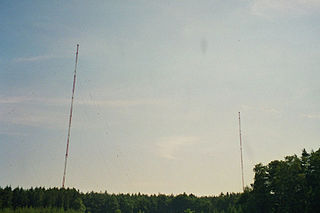
The Sender Donebach was a 500-kilowatt long wave radio transmitter operating on 153 kHz and transmitting the program of German public broadcaster Deutschlandfunk. The facility, which was the property of Media Broadcast, was built between 1965 and 1967 on a former airfield, and entered service on March 10, 1967.

The Longwave transmitter Europe 1 was the oldest privately owned radio station in Germany, situated between Felsberg and Berus/Saar, Germany. It transmitted on 183 kHz with a power of 2,000 kilowatts a French speaking programme, Europe 1 toward France. It was the highest power radio broadcasting transmitter in Germany. Longwave transmissions stopped on 31 December 2019.

The Roumoules transmitter is the main broadcasting facility for longwave and mediumwave broadcasting of Radio Monte Carlo near Roumoules, France and is owned by Monaco Media Diffusion. The 1000 and 2000kW transmitters installed are among the most powerful in the world and can be received well at nighttime throughout Europe.

The Mühlacker Broadcasting Transmission Facility is a radio transmission facility near Mühlacker, Germany, first put into service on November 21, 1930. It uses two guyed steel tube masts as aerials and one guyed steel framework mast, which are insulated against ground. It has two transmission aerials for shortwave and one free standing steel framework tower for directional radio services. The shortwave transmitter was shut off on October 19, 2004. The medium wave transmitter was switched off in January 2012.

The Langenberg transmission tower is a broadcasting station for analog FM Radio and Digital-TV signals. It is located in Langenberg, Velbert, Germany and owned and operated by Westdeutscher Rundfunk, WDR.
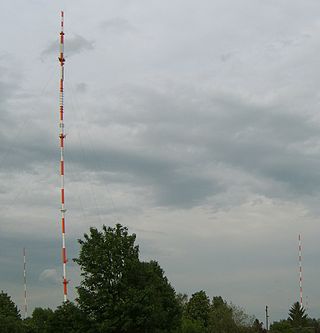
The Transmitter Hamburg-Billstedt is a broadcasting facility in Hamburg-Billstedt, established in 1934. It is owned and operated by the Norddeutscher Rundfunk public broadcasting service, but open to competitors, too.

Transmitter Berlin-Britz was a broadcasting facility for medium wave, shortwave and FM on the site of a former tree nursery in Berlin-Britz. It was established in 1946 and until 1993 it was the most important transmitter of RIAS. It was used by Deutschlandradio until 4 September 2013, and was finally demolished on 18 July 2015.
The Fernmeldeturm Berlin is a telecommunication tower located atop the Schäferberg hill in Berlin-Wannsee. The tower was built between 1961 and 1964, and is not open to the public. Owner and operator of the site is Deutsche Funkturm (DFMG), a subsidiary of Deutsche Telekom.

The Rheinsender is an FM radio transmission site for the German Südwestrundfunk regional public broadcasting system. The Rheinsender is located near Wolfsheim, southwest of Mainz.
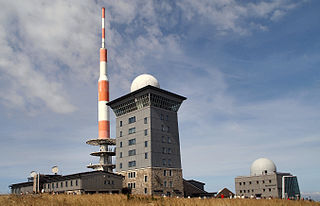
The Brocken Transmitter is a facility for FM- and TV-transmitters on the Brocken, the highest mountain in Northern Germany.

The Feldberg/Taunus transmitter is a facility for FM- and TV-broadcasting and for directional radio services located on the Großer Feldberg, the highest mountain in the Taunus region of Germany.

The Sender Inselsberg is an FM, DAB+ and television-transmission facility on the Großer Inselsberg in Thuringia, Germany. It has two aerial towers, which were built in 1939 and 1974.

The Mediumwave transmitter Lopik was a medium wave broadcasting facility near Lopik in the Netherlands. It was constructed in 1938 and destroyed on September 1, 2015. Its last use was to transmit the Dutch language edition of Radio Maria on 675 kHz. The aerial consisted of a 196-metre (643 ft) guyed steel framework mast, which was insulated against ground.
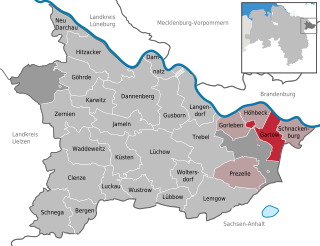
Gartow is a municipality in the district Lüchow-Dannenberg, in Lower Saxony, Germany. It is situated in the easternmost tip of Lower Saxony, not far from the river Elbe, approx. 30 km northeast of Salzwedel, and 20 km west of Wittenberge. Gartow is also the seat of the Samtgemeinde Gartow.
Goliath transmitter was a very low frequency (VLF) transmitter for communicating with submarines, built by Nazi Germany's Kriegsmarine navy near Kalbe an der Milde in Saxony-Anhalt, Germany, which was in service from 1943 to 1945. It was capable of transmission power of between 100 and 1000 kW and was the most powerful transmitter of its time.

Gartow-Höhbeck transmitter is a large facility for FM and TV transmission in Lower Saxony, Germany, situated behalf of the communities of Gartow and Höhbeck.
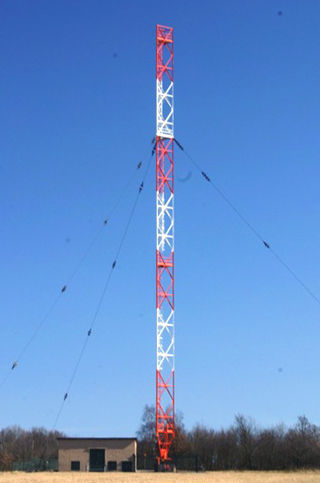
Marnach transmitter was a broadcasting facility of RTL near Marnach in the commune of Clervaux, in northern Luxembourg. The Marnach transmitter was built in 1955 for improving the transmission of the English-speaking program on 1439 kHz, which was transmitted from 1951 with an omnidirectional antenna from Junglinster, to the British Isles and for a better transmission on this frequency to Germany at daytime. Therefore, it was given a directional antenna with a switchable directional characteristic pointing north-northeast towards the Rhine-Ruhr area, Germany's most populated area, and west-northwest in the direction of the UK. This antenna was implemented in form of a directional antenna consisting of three ground-fed 105-metre-tall (350 ft) guyed mast antennas arranged in the form of an isosceles triangle with a 90-degree angle. As transmitters, two 100 kW units switched in parallel were used when it went in service in December 1955.

The Ochsenkopf Transmitter is a 163 metres (535 ft) radio and TV tower of reinforced concrete, which was built in 1958 on the summit of the 1,024 metres (3,360 ft) Ochsenkopf mountain, the second-highest mountain in the Fichtel Mountains in Northern Bavaria, Germany. The tower replaced a 50 metres (160 ft) guyed steel tube TV mast that collapsed in January 1958 as result of icing. The tower, which is not accessible to the public, has a hyperbolic-shaped basement with five floors for technical equipment. Above it, there are platforms for directional antennas. The antennas for FM-transmission are on the upper part of the concrete tower, those for TV transmission on a steel tube mast on the top.



















